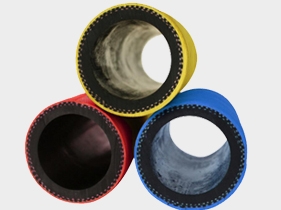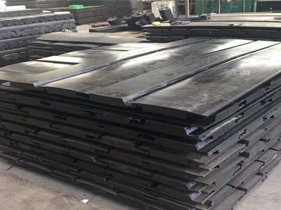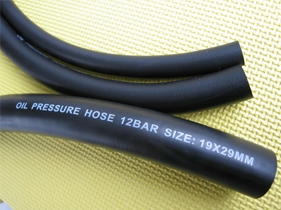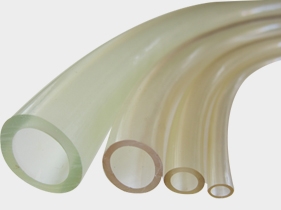
wear-resisting Extruded tube It is characterized by high pressure, fire resistance, heat insulation, beautiful pipe body, corrosion resistance, anti-static, high wear resistance, light weight, high and low temperature resistance, good low-temperature bending performance, and long service life. Use: oilfield well control operation, metal smelting, chemical industry, etc. High temperature environment with heat source or thermal radiation. Hydraulic control pipeline of BOP for oil exploration and drilling. High pressure flame-retardant sand blasting pipe is mainly used for hydraulic transmission, medium transmission or power transmission under high-pressure, flammable and high-temperature environment. This product has been widely used in petroleum, chemical, marine, metallurgical and other industries. Flame retardant and fire-resistant: structure: take high temperature and high pressure steel wire winding hose as the base, and the outer skin is covered with nano fire-resistant coating, stainless steel wire braid and flame retardant layer. Hydraulic pipes in high-temperature environment near open fire, such as metallurgical industry, steelmaking, blast furnace, open hearth furnace, etc. Main Uses Hydraulic transmission is widely used in petroleum, chemical, marine transportation media or power transmission under high-pressure, flammable and high-temperature environments. Our products flame retardant sand blasting pipes are characterized by high pressure resistance, fire resistance, heat insulation, oil resistance, acid and alkali resistance. Extruded tube Where can I find it? When used in oil drilling well control system, it is superior to ordinary hard pipes, safe and reliable, easy to install and disassemble, time-saving, labor-saving, corrosion resistant, maintenance free, and long service life. Fire resistance: it can work for 15 minutes at 750 ℃. Oil resistance: Immerse in hydraulic oil at 40 ℃ - 100 ℃ for 24 hours without deterioration or falling off.

I believe everyone is familiar with wear-resisting Extruded tube Relevant application knowledge of products. It is understood that at present, this product is mainly used for mining hydraulic support and oilfield development. It is applicable to engineering construction, lifting transportation, metallurgical forging, mining equipment, ships, injection molding machinery, agricultural machinery, various machine tools, mechanization of various industrial departments, water-based liquids, etc. And liquid transmission. Its relatively high working pressure can reach 70-120 MPa. In order to achieve better application effect, what problems should be paid attention to when using high-pressure braided hose? 1. The bending radius shall not be less than the given bending radius to prevent damage to the hose skeleton or premature failure due to excessive tension. 2. Select the type and specification of the hose correctly according to the use conditions, and do not misuse or replace it. 3. When using high-pressure braided hose, the pressure should be adjusted slowly and evenly to avoid sudden pressure increase and damage to the pipe body. 4. When the work site changes, it should be removed from the ground without dragging, so as to avoid the skeleton layer being corroded after scratching the outer glue. 5. After delivering corrosive liquid, the interior should be cleaned to prevent residues from corroding the pipe body for a long time, or select corresponding series of products. When storing high-pressure braided rubber hoses, depending on the type of rubber used, Extruded tube Where can I find it? Note which conditions typically change over time. However, due to several factors or a combination of several factors, this change may accelerate, and other materials used to strengthen high-pressure braided hoses may also be adversely affected by improper storage conditions.

polyurethane wear-resisting Extruded tube Maintenance measures; Cleaning: It is recommended to empty the hose after use. Clean if necessary. Inspection: After each use, the rubber tube must be inspected to ensure that there is no structural damage. Pressure: If the rubber pipe is under great pressure during use, or the outer layer of the rubber pipe will contact with the conveyed liquid for a long time, it is recommended to conduct a hydrostatic test. Due to the natural characteristics of rubber, the physical properties and performance levels of all rubber products will change. This change usually occurs over time, depending on the type of rubber used. However, changes may also accelerate due to several factors or a combination of several factors. Other materials used to reinforce rubber tubing may also be adversely affected by improper storage conditions. Detailed step 1. Polyurethane sand blasting pipe mandrel: the mandrel is usually pulled backward, mainly to increase the firmness of the connection between the mandrel and the hose. After the spindle barb processing is completed, the barb tip must also be passivated, otherwise the barb tip will pierce the lining material of the high-pressure rubber tube during the buckling process. Extruded tube Where can I find it? Even if the high-pressure rubber pipe joint is firmly buckled, if the inner layer is damaged, high-pressure water will leak from the buckle. 2. Polyurethane sand blasting pipe sheath: the sheath is generally in the form shown in the figure, the wall thickness should be moderate, and the internal rectangular tooth height should not exceed 2mm, that is, (d-d) should not exceed 4mm.

Changchun Extruded tube It is one of the most common rubber products in life, used to transport various gases and liquids. Natural rubber, synthetic rubber and reclaimed rubber in rubber products can be used for the consumption of rubber sand blasting pipes. When reclaimed rubber is used to consume odorless rubber sand blasting pipe, care must be taken in selecting reclaimed rubber and formula design to meet the performance requirements of odorless rubber sand blasting pipe. When using recycled rubber to consume odorless rubber sand blasting hose, what problems should we pay attention to? The selection of reclaimed rubber for odorless rubber sandblasting hose is the basis for determining the quality of rubber, whether it is environmental protection rubber products or various odorless rubber products. When using reclaimed rubber to consume odorless hose, choosing odorless reclaimed rubber is the top priority. Application of odorless reclaimed latex, odorless reclaimed tire rubber, odorless reclaimed nitrile rubber and odorless reclaimed ethylene propylene rubber in reclaimed rubber products. The odorless butyl reclaimed rubber can be used for the consumption of odorless rubber sandblasting pipes. In addition, odorless hb isoprene reclaimed rubber can also be used for consumption of odorless rubber sandblasting pipes. In actual consumption, the raw materials of odorless isoprene reclaimed rubber (PP reclaimed rubber) are isoprene unvulcanized composite rubber and isoprene bottle stopper. They have strong viscosity, aging resistance and temperature resistance, and are ideal for odorless hose consumption to ensure quality and reduce costs. Pay attention to the vulcanization of odorless rubber sand blasting pipe. as everyone knows, Extruded tube Where can I find it? The design of vulcanization system of reclaimed rubber products directly affects the quality of rubber products, and the odorless rubber sand blasting pipe of reclaimed rubber is no exception. When using reclaimed rubber to consume odorless rubber sand blasting pipe products, vulcanizing agent, accelerator and other additives must be combined with odorless additives such as accelerator STT and accelerator D; When vulcanizing the rubber of odorless rubber sand blasting pipe, it is better to vulcanize at low temperature for a long time, which will cause full reaction to the rubber.






